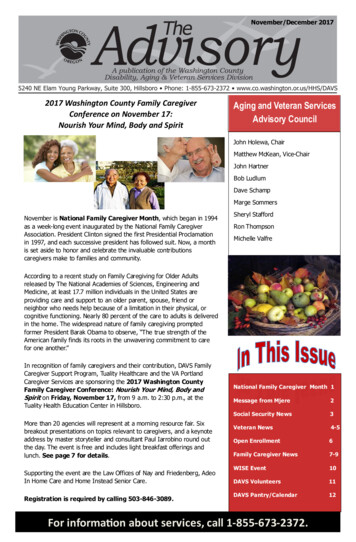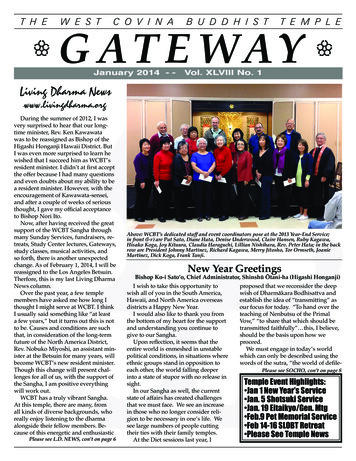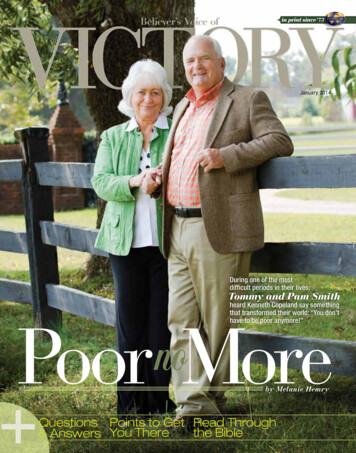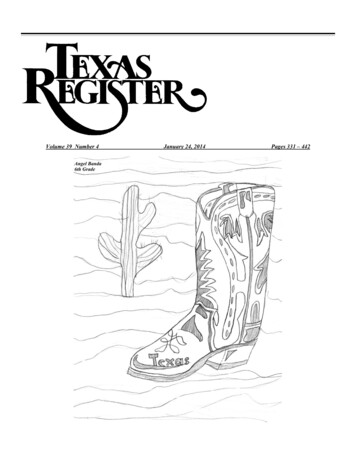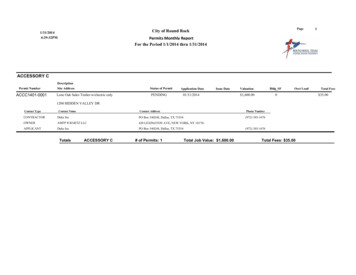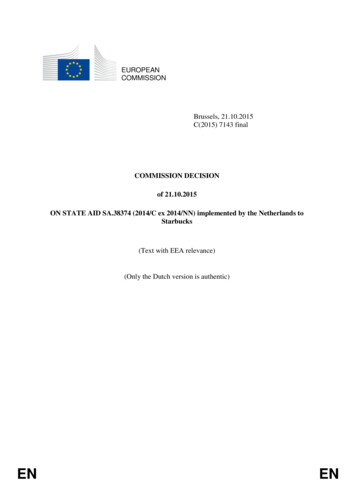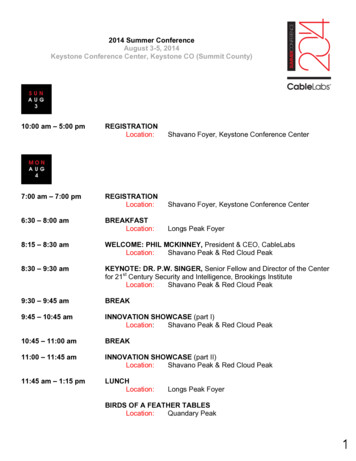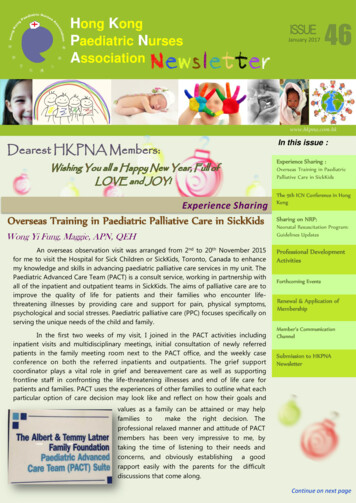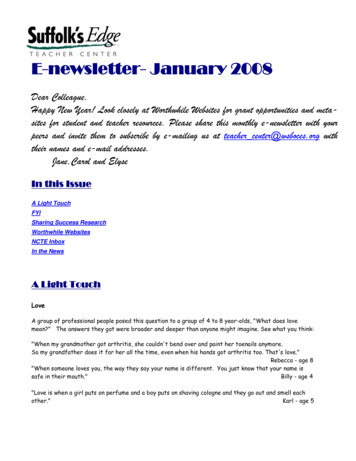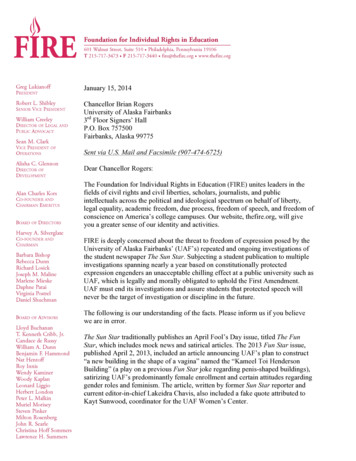
Transcription
January 15, 2014Chancellor Brian RogersUniversity of Alaska Fairbanks3rd Floor Signers’ HallP.O. Box 757500Fairbanks, Alaska 99775Sent via U.S. Mail and Facsimile (907-474-6725)Dear Chancellor Rogers:The Foundation for Individual Rights in Education (FIRE) unites leaders in thefields of civil rights and civil liberties, scholars, journalists, and publicintellectuals across the political and ideological spectrum on behalf of liberty,legal equality, academic freedom, due process, freedom of speech, and freedom ofconscience on America’s college campuses. Our website, thefire.org, will giveyou a greater sense of our identity and activities.FIRE is deeply concerned about the threat to freedom of expression posed by theUniversity of Alaska Fairbanks’ (UAF’s) repeated and ongoing investigations ofthe student newspaper The Sun Star. Subjecting a student publication to multipleinvestigations spanning nearly a year based on constitutionally protectedexpression engenders an unacceptable chilling effect at a public university such asUAF, which is legally and morally obligated to uphold the First Amendment.UAF must end its investigations and assure students that protected speech willnever be the target of investigation or discipline in the future.The following is our understanding of the facts. Please inform us if you believewe are in error.The Sun Star traditionally publishes an April Fool’s Day issue, titled The FunStar, which includes mock news and satirical articles. The 2013 Fun Star issue,published April 2, 2013, included an article announcing UAF’s plan to construct“a new building in the shape of a vagina” named the “Kameel Toi HendersonBuilding” (a play on a previous Fun Star joke regarding penis-shaped buildings),satirizing UAF’s predominantly female enrollment and certain attitudes regardinggender roles and feminism. The article, written by former Sun Star reporter andcurrent editor-in-chief Lakeidra Chavis, also included a fake quote attributed toKayt Sunwood, coordinator for the UAF Women’s Center.
Offended by the article and the accompanying image, UAF Professor Jensine Anahita filed asexual harassment complaint against The Sun Star on April 5, 2013. Anahita claimed that thearticle’s accompanying graphic—a still depicting oversized legs protruding from a building,taken from the 1998 PG-13 film Patch Adams—was “patently offensive to reasonable personssuch as myself” and stating, “sexual jokes, graphic displays of women’s genitals, and use ofsexual slang creates a hostile environment because it comprises sexual harassment.” Anahita alsoclaimed that many UAF students, faculty, and staff had told her that they were upset by thegraphic.UAF Director of Diversity and Equal Opportunity Mae Marsh reviewed Anahita’s complaint inconsultation with UAF’s legal department. On April 15, 2013, Marsh informed Anahita via letterthat UAF would not investigate the complaint, because the article and its accompanying imagewere protected by the First Amendment and did not constitute sexual harassment. In this letter,Marsh expressly noted that “an investigation of [Anahita’s] sexual harassment complaint or anyaction against the student newspaper would be inappropriate.”On April 23, The Sun Star published an article titled “UAF Confessions harbors hate speech,”detailing interactions on the public Facebook group UAF Confessions. The article posted severalscreenshots of student conversations from the public Facebook page, including the names andprofile photographs of UAF students commenting on the site. All information contained in thearticle was publicly available.On April 30, Anahita filed a second complaint accusing The Sun Star of harassment. Anahitaclaimed that The Sun Star committed further sexual harassment by publishing the April 23article. Anahita argued that the article’s content was “sexually harassing in nature” andconstituted “cyberbullying,” which she stated was “definitely prohibited under Title IX.” Shealso accused The Sun Star of having engaged in “sexual slander” against Sunwood (to whom thefake quote had been attributed) and the students named in the April 23 article. Anahitaadditionally claimed that the article “perpetuat[ed] a hostile environment for women and forLGBTs.” Finally, Anahita renewed her complaint that The Sun Star’s April 5 article violatedUAF’s sexual harassment policy, and stated that UAF had violated Title IX by declining toinvestigate her April 5 complaint.Jennifer McConnel, the University of Alaska system’s Labor Employee Relations Coordinator,investigated Anahita’s April 30 complaint. The investigation included interviews of several SunStar staff members, The Sun Star’s advisor, and other UAF personnel. The concluding report,signed by UAF Title IX Coordinator Ana Richards, was dated September 27, 2013, but The SunStar staffers implicated by the complaint were not provided copies. Sun Star advisor Robyne didnot receive a copy until October 31.The report rejected Anahita’s claims. The 22 page report found, among other conclusions, that“[n]o evidence was presented that portrayed the failure to investigate the [April 5] complaintnegatively impacted any students or employees [sic];” “there is no evidence that the fake quoteled to a tangible employment action or altered Sunwood’s conditions of employment;” and that“[t]here is no evidence that the articles affected any students [sic] education.” The report flatly2
rejected the general claim that the cumulative effect of the two articles was sufficiently pervasiveto constitute harassment:There is no evidence that the conduct affected the work environment or Sunwoodor any other UAF employee. There is no evidence that the conduct affected thelearning environment of any student at UAF. There were two articles written. Thetwo articles were isolated. Without a pattern of discriminatory intimidation,ridicule or insult, pervasiveness cannot be found.Anahita appealed both Marsh and McConnel’s findings on October 11. Following Anahita’sappeal, UAF retained attorney Parry Grover to review the investigations and their conclusions.Grover is conducting yet another investigation, during which he has contacted Robyne for thepurpose of requesting copies of other articles written by Chavis. Chavis has repeatedly contactedGrover to request updates on his review, only to be told in emails of December 13, 2013 andJanuary 1, 2014 that he was waiting for “additional information.”In total, UAF’s investigations of The Sun Star have now been ongoing for more than ninemonths, with no indication that a conclusion is near.FIRE recognizes and affirms UAF’s moral and legal obligation to promptly and thoroughlyrespond to allegations of harassment. Accordingly, Anahita’s right to file complaints is not atissue. However, when harassment complaints solely concern expression protected by the FirstAmendment, no further investigation or consideration is warranted or permissible. As such, therepeated investigations of The Sun Star are unacceptable. The newspaper’s articles areunequivocally protected by the First Amendment and do not meet the legal standard forharassment in the educational setting. By subjecting The Sun Star to further investigation—evenafter correctly finding the speech to be protected on two separate occasions—UAF hasdisregarded its binding obligation to uphold the First Amendment on campus. Given the stressand disruption caused by lengthy formal investigations and the ongoing prospect of punishment,UAF students and student journalists will rationally refrain from engaging in protectedexpression for fear that they will face similarly lengthy investigations and potential discipline atthe whim of any offended observer. Chilling speech violates the First Amendment rights of UAFstudents and cannot be tolerated.It is well-settled law that the First Amendment is fully binding on public institutions like UAF.See Widmar v. Vincent, 454 U.S. 263, 268–69 (1981) (“With respect to persons entitled to bethere, our cases leave no doubt that the First Amendment rights of speech and association extendto the campuses of state universities.”); Healy v. James, 408 U.S. 169, 180 (1972) (“[T]heprecedents of this Court leave no room for the view that, because of the acknowledged need fororder, First Amendment protections should apply with less force on college campuses than in thecommunity at large. Quite to the contrary, the vigilant protection of constitutional freedoms isnowhere more vital than in the community of American schools.”) (internal citation andquotation marks omitted).The principle of freedom of speech does not exist to protect only non-controversial speech;indeed, it exists precisely to protect speech that some members of a community may find3
controversial or offensive. The right to free speech includes the right to say things that are deeplyoffensive to many people, and the U.S. Supreme Court has explicitly held, in rulings spanningdecades, that speech cannot be restricted simply because it offends some, or even many,listeners. See, e.g., Terminiello v. Chicago, 337 U.S. 1, 4 (1949) (noting that free speech “mayindeed best serve its high purpose when it induces a condition of unrest or even stirs people toanger. Speech is often provocative and challenging. It may strike at prejudices andpreconceptions and have profound unsettling effects as it presses for acceptance of an idea.”).Indeed, much protected expression—including parody and satire—exists precisely to challenge,to amuse, and even to offend, and such speech is unambiguously protected under the FirstAmendment. In Hustler Magazine v. Falwell, 485 U.S. 46 (1988), the Supreme Court ruled thatthe First Amendment protects even the most blatantly ridiculing, outlandishly offensive parody.There can be no doubt that The Sun Star’s satire of campus architecture and gender issues isentitled to full First Amendment protection.Moreover, neither of the articles at issue constitutes actionable harassment. In Davis v. MonroeCounty Board of Education, 526 U.S. 629 (1999), the Supreme Court set forth a strict definitionof student-on-student (or peer) harassment. In order for student behavior to constitute actionableharassment, it must be (1) unwelcome, (2) discriminatory on the basis of gender or anotherprotected status, (3) directed at an individual, and (4) “so severe, pervasive, and objectivelyoffensive that it can be said to deprive the victim[] of access to the educational opportunities orbenefits provided by the school.” Id. at 650. By definition, this includes only extreme andunusually repetitive behavior—conduct so serious that it would prevent a reasonable person fromreceiving his or her education. Furthermore, in a July 28, 2003, “Dear Colleague” letter sent toall college and university presidents, Assistant Secretary Gerald A. Reynolds of the Office forCivil Rights (OCR) of the U.S. Department of Education made clear that harassment “mustinclude something beyond the mere expression of views, words, symbols or thoughts that someperson finds offensive.” In a 2010 “Dear Colleague” letter regarding bullying, AssistantSecretary Russlynn H. Ali explicitly reaffirmed the 2003 letter’s understanding of therelationship between the First Amendment and harassment.Nothing in the April 2 Fun Star article approaches the level of severity, pervasiveness, andobjectively offensive conduct required to satisfy the Supreme Court’s binding standard foractionable harassment. It would in fact be difficult for anything printed in a single issue of anewspaper, let alone a single article, to reach the necessary level of severity and pervasiveness toconstitute harassment—particularly given that no student is required to read either The Sun Staror The Fun Star.The Sun Star’s April 23 article similarly fails to meet the Supreme Court’s definition of hostileenvironment harassment in the educational context. Foremost, the article cannot reasonably beinterpreted as discriminatory. Rather, the article was an objective investigative report ofcontroversial and often hostile speech transmitted anonymously through a publicly availablewebsite. The publication of such a news article is deserving of the highest constitutionalprotection and does not constitute discriminatory harassment any more than would an articledescribing a rally, protest, or other expressive activity of a racist or homophobic group. Thepublication of images captured from the public Facebook page discussed by the article issimilarly protected by the First Amendment. Finally, as noted, the publication of a single article4
does not constitute sufficiently severe and pervasive conduct to transform this protected speechinto actionable harassment. Nor do the two articles, taken together, render The Sun Star’s speechhostile environment harassment. Indeed, McConnel’s findings expressly acknowledge that thetwo articles at issue failed to meet the threshold of pervasiveness necessary for a finding ofactionable harassment due to their separate and distinct nature.FIRE is encouraged by the fact that UAF’s internal investigators expressly concluded that thearticles in question were constitutionally protected speech rather than harassment. However,pursuant to its obligations as a public institution bound by the First Amendment, UAF shouldhave recognized that it had no grounds to investigate The Sun Star in the first place, let alone tosubject it to repeated investigations spanning months. UAF ought to have immediatelyrecognized that the articles are unambiguously protected by the First Amendment and disposedof Anahita’s complaints. Instead, not only did UAF investigate The Sun Star, it has nowauthorized another months-long investigation that continues to this day, even after explicitlydetermining that the speech at issue is constitutionally protected.The nearly year-long investigation of The Sun Star must be concluded immediately. Governmentactions violate First Amendment rights when they “would chill or silence a person of ordinaryfirmness from future First Amendment activities.” Mendocino Environmental Center v.Mendocino County, 192 F.3d 1283, 1300 (9th Cir. 1999). Accordingly, courts have longacknowledged that government investigations into protected speech risk violating the FirstAmendment. In Sweezy v. New Hampshire, 354 U.S. 234, 245, 248 (1957), the Supreme Courtnoted that government investigations “are capable of encroaching upon the constitutionalliberties of individuals” and have an “inhibiting effect in the flow of democratic expression.”Similarly, the Court later observed that when issued by a public institution like UAF, “the threatof invoking legal sanctions and other means of coercion, persuasion, and intimidation” mayviolate the First Amendment. Bantam Books, Inc. v. Sullivan, 372 U.S. 58, 67 (1963).The United States Court of Appeals for the Ninth Circuit—the decisions of which are fullybinding on UAF—has held that an eight-month government investigation into clearly protectedexpression chilled protected speech, and therefore violated the First Amendment. See White v.Lee, 227 F.3d 1214, 1228 (9th Cir. 2000). Additionally, in Levin v. Harleston, 966 F.2d 85 (2dCir. 1992), the United States Court of Appeals for the Second Circuit upheld a trial court’sfinding that a university president’s creation of a committee to investigate protected speech by aprofessor unconstitutionally chilled protected expression because it implied the possibility ofdisciplinary action.UAF has declined to comment on these investigations, stating its desire to avoid creating “achilling effect on people’s willingness to report things.”1 Sadly, UAF has not demonstratedsimilar concern about the chilling effect that its investigations have had on student speech. To beclear: UAF’s prolonged investigations of The Sun Star have undoubtedly chilled protectedspeech on campus. If UAF is willing to subject The Sun Star to investigation because of mereoffense taken to its satire and reporting on important campus issues, what reasonable student1Samantha Sunne, University of Alaska Fairbanks student newspaper under investigation following sexualharassment claims, SPLC NEWS FLASHES (Nov. 26, 2013), available athttp://www.splc.org/news/newsflash.asp?id 2641.5
would not refrain from expressing views, making jokes, or engaging in other constitutionallyprotected speech that might offend others?These concerns are not hypothetical. The Sun Star and its staff have been left uncertain as towhether they will face disciplinary action for the articles being investigated as a result ofAnahita’s complaints. The stress, uncertainty, and fear of future complaints and subsequentinvestigations have affected The Sun Star’s operations and organizational approach, leaving it farless likely to publish materials that would cause offense. Moreover, UAF’s actions havedemonstrably chilled campus expression more broadly. On September 10, 2013, Lakeidra Chavispublished an article in The Sun Star regarding UAF’s investigations, noting that “students arehesitant to speak out against the university because they are either planning on attendinggraduate school, applying for a job or working for a department and are afraid of retaliation.”2Indeed, UAF’s actions have cast such a severe chill that even its student journalists have toquestion whether it is worth the trouble to engage in traditional journalism: “If this is the price ofJournalism, the price of reporting the truth, of writing satire,” Chavis wrote, “it is time to reevaluate our current expectations, perceptions and understanding of the role of media.”FIRE reminds you that in the past, the University of Alaska system has been stalwart in itsdefense of free speech on campus, despite the offense that some may take to controversial,dissenting, or otherwise unpopular speech. In a memorandum issued March 13, 2001, Mark R.Hamilton, former President of the University of Alaska system, responded to a controversyinvolving University of Alaska at Anchorage (UAA) Professor Linda McCarriston, a renownedpoet. McCarriston’s poem “Indian Girls,” concerning the sexual abuse of children, had generatedcontroversy following its publication in the December 2000 issue of Ice-Floe: InternationalPoetry of the Far North. UAA administrators called for an investigation of the matter.Concerned, FIRE co-founder and former President Alan Charles Kors wrote Hamilton in Januaryin defense of McCarriston’s right to freedom of expression.Following Kors’ letter, Hamilton issued his March 13 memorandum to system chancellors.Leaving no doubt about the primacy of freedom of expression on Alaska’s public campuses,Hamilton instructed that “[o]pinions expressed by our employees, students, faculty, andadministrators don't have to be politic or polite, however personally offended we might be.”Hamilton could not have been clearer. “I insist that we remain a certain trumpet on this mostprecious of constitutional rights,” he wrote; “What I want to make clear and unambiguous is thatresponses to complaints or demands for action regarding constitutionally guaranteed freedoms ofspeech CANNOT BE QUALIFIED.” [Emphasis in original.] Hamilton was equally clear withregard to the chilling effect of investigations into protected speech, such as that at issuepresently. He notified chancellors that protected speech must not be subject to investigation:“Noting that, for example, ‘The University supports the right of free speech, but we intend tocheck into this matter,’ or ‘The University supports the right of free speech, but I have askedDean X or Provost Y to investigate the circumstances,’ is unacceptable. There is nothing to2Lakeidra Chavis, On silence and accountability, SUN STAR, Sept. 10, 2013, available -accountability.6
‘check into,’ nothing ‘to investigate.’” Hamilton’s brave and necessary defense of freedom ofexpression earned local and national commendation.3The University of Alas
Jan 15, 2014 · The investigation included interviews of several Sun Star staff members, The Sun Star’s advisor, and other UAF personnel. The concluding report, signed by UAF Title IX Coordinator Ana Richards, was dated September 27, 2013, but The Sun Star staffers implicated by the complaint were not provided copies. Sun Star advisor Robyne did
